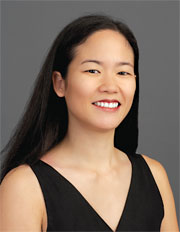Healing HeARTS: Packard Children's program offers creative outlet to sick kids
Chance to paint, draw and sculpt helps patients at Lucile Packard Children's Hospital rise above the pain and build self-esteem
The photo shows a stark wire sculpture of an agitated Elvis-like face with a corkscrew tongue and a red-pipe-cleaner eye. "[Art] takes my mind off things," reads the caption beneath the work.
Indeed, the sculptor—16-year-old Dominic Gallardo—had problems he wanted to put aside. He was a patient at Lucile Packard Children's Hospital, and the work he created with the help of hospital staff is now part of an exhibition at Lane Medical Library that runs through February. The show comprises reproductions of 22 artistic creations that children and teenagers, from ages 6 to 18, made under the auspices of Healing HeARTS, a project at Packard Children's that provides patients with a creative outlet while also giving a boost to their self-esteem.
The works in this show offer a brief but telling glimpse into the minds of young patients, with a range in tone from fearful to courageous, philosophical to triumphant. A tranquil drawing of flowers and stuffed animals by 14-year-old Emily Ho sports a simple message of hope: "Recovery is possible." Ten-year-old Douglas Brown wrote, "I am a pirate ship in a storm," about his picture of a sailboat on rough waters. And at age 7, Madison Kitz appears to have already grasped the transformative power of art in describing her self-portrait. "I am happy in this picture, and it makes me feel good!" she wrote.
Grace Cheng, MD, a Packard Children's general pediatric hospitalist and a clinical instructor at the medical school, established the project in September 2003 and is currently seeking funding to extend it. She had suffered from asthma as a child and was well-aware that when children are ill, they are unable to participate in sports and other common childhood activities that promote feelings of confidence. She wanted Healing HeARTS to compensate for the absence of such extracurricular activities and give the participants the satisfaction of seeing their work publicly displayed.
Healing HeARTS also helps medical students by giving them a chance to interact with individual children in a non-medical setting. "Physicians sometimes have to inflict pain and suffering on kids during treatment," said Cheng. "This project is a way to help prospective doctors see kids as people, not just as diseases."
Brian Le, a third-year medical student who is now president of Healing HeARTS, found that working one-on-one with kids over a 10-week period enhanced his understanding of pediatrics. "Kids' experience of illness is very different than adults'," he said.
Le noted that the Healing HeARTS program has evolved since it started. Initially he and other staff members were wary of focusing too much on the kids' medical situations. Over the past two years, however, they have found that many children are willing to talk about their health issues when discussing their art. The artwork, not the illness, temporarily becomes the focus. "The children are proud of their work and they want to be identified with it," Le said.
For each of the past two years, roughly 60 to 80 children have worked with the staff of the recreational therapy department to produce their artistic creations. Healing HeARTS then reproduced the work in two vibrantly colored magazines, which were published in October 2004 and 2005 under Le's direction. The Stanford Blood Center also published a 2006 calendar that features the creations of kids in the program who received transfusions during their hospital stays. (This calendar is being offered as a gift to blood donors.) What's more, the closed-circuit television system at the children's hospital regularly displays many of the pieces.
Seven-year-old Brennah Payne is pleased that her picture, "Little Mermaid," was published on the calendar's cover, but the making of the work was just as important to her. Brennah, who was hospitalized after being injured in a car accident, found that Healing HeARTS provided a haven during her 24-week stint that included a number of surgeries. "Doing art helped me think of other things and distracted me," she said. "It even helped me forget about my stomach pain and not being able to eat."
Heather Payne, Brennah's mother, said the program enabled her daughter to make new friends in the hospital. "The art program brought together kids of all ages and with all different types of medical conditions." And she also noticed that the chance to create art actually changed how her daughter behaved.
"I saw fewer emotional outbursts and negative attitudes because Brennah had this outlet," she said. "When Brennah was able to do art, she was at peace with herself."
For more information about the program, please contact Cheng at Dr.Grace.Cheng@stanford.edu.
Patti Kahn is a science-writing intern in the Office of Communication & Public Affairs at the School of Medicine.





Share This Story